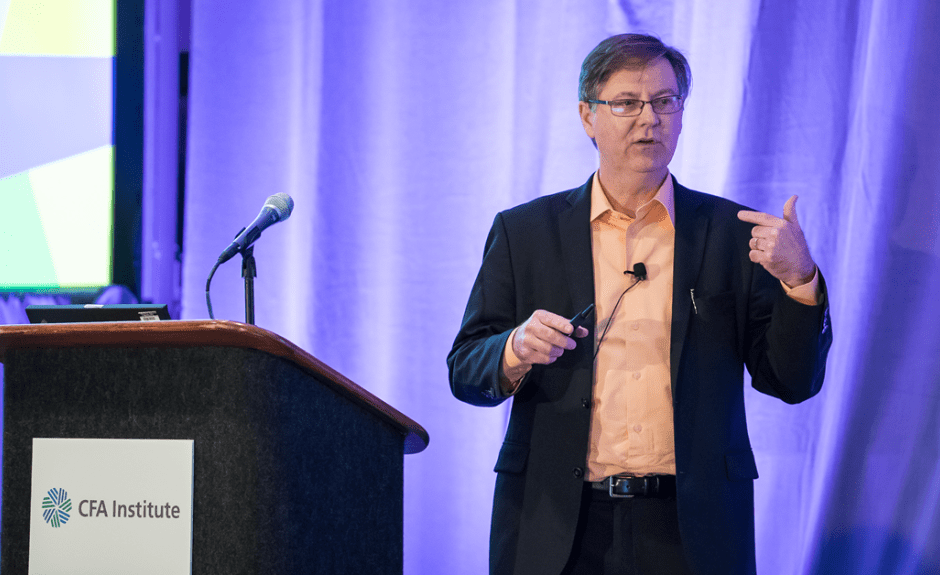This edition of Conference Collections features a presentation by Campbell R. Harvey, Professor of Finance at Duke University, from the 2017 CFA Institute Annual Conference.
Content from this session includes a blog post, webcast of the presentation, key takeaways from this session, and a transcript of the presentation. This collection of products is eligible for 1.5 continuing education (CE) credits.
Blockchain 101 with Campbell R. Harvey
By Larry Cao, CFA
There has been much talk about blockchain disrupting the financial services industry. In May 2017, IBM’s vice president of blockchain, Jerry Cuomo, declared 2016 “the year of blockchain experimentation,” and 2017 “the year of adoption.” (That IBM has an executive with “blockchain” in their job title is a data point by itself.)
So, what is blockchain? What will it do to our industry? At the 70th CFA Institute Annual Conference, Campbell R. Harvey led an extended presentation on the subject.
What is blockchain, and what does trust have to do with it?
“Blockchain is a technology,” Harvey explained. “It is a distributed ledger, which means it can be quickly and easily accessed by many.” He also said that blockchain “is immutable, which means you can only add to it, but not alter history. And it is cryptographically secured.”
Based on accessibility, blockchain is divided into public and private blockchains. While public blockchains do not require trust to access — they are open to all — access to private blockchains is restricted and trust is required. The distinction becomes very important in blockchain’s applications.
What can blockchain technology do? Take a look at bitcoin.
Harvey believes blockchain can solve many problems, but that it is particularly good at two broad types of applications: verification and efficient exchange of ownership.
Bitcoin is a public blockchain that has exactly those two features. The public nature of the ledger ensures transparency. Ownership can be verified on the network, as all past transactions are stored on the network for all to see.
Bitcoin is also a testament to blockchain technology’s security, which is critical for storing and transferring value. Each “block” of transaction data on the bitcoin network needs to be accepted by the later blocks in the chain. The process has ensured that “hacking” bitcoin, say, by altering historical transaction data, is not even remotely feasible.
Per Harvey, the probability of successfully altering transaction data on the bitcoin network is about 1/1000th the odds of winning two Powerball jackpots in a row!
What will be disrupted?
Harvey thinks blockchain will transform the financial services industry by cutting out the middleman. Financial institutions are frequently referred to as financial intermediaries, and those intermediation activities are the ones that Harvey expects to be disrupted first. But it does not stop there. The payment business provides a good case study.
In the traditional banking setup, money is transferred from one customer’s account to another via the payment networks that banks belong to. Blockchain threatens to change all that by enabling what Harvey calls “machine-to-machine payment.” When two machines are connected through blockchain technology, they can make instant payments to each other. More broadly, these machines can receive real-time financial statements for transactions performed with any other machine connected to the same blockchain.
And it does not stop there. Harvey cited property markets and digital currency issued by central banks as examples. The former make title insurance obsolete, and the latter has tremendous potential to reduce money laundering activities. Machine-to-machine payment may even help counteract spam emails and DDoS attacks.
There are significant regulatory hurdles and substantial time and effort are required to develop and implement practical applications. Harvey remains optimistic, however. As he closed his presentation, he declared that “blockchain is not going away.”
This article originally appeared on the 70th CFA Institute Annual Conference blog. Experience the conference online through the Virtual Link. It’s an insider’s perspective with archived videos of select sessions, exclusive speaker interviews, discussions of current topics, and updates on CFA Institute initiatives.
If you liked this post, don’t forget to subscribe to the Enterprising Investor.
Key Takeaways
- Blockchain is a cryptographically secured, distributed ledger. It can be quickly and easily accessed by many, who are able to add to the chain, but they cannot alter its history.
- Harvey believes blockchain can solve many problems, but that it is particularly good at two broad types of applications: verification and efficient exchange of ownership.
- Blockchain technology can transform the financial services industry by enabling machine-to-machine payment: Machines connected through blockchain technology can make instant payments to each other, and these machines can receive real-time financial statements for transactions performed with any other machine connected to the same blockchain.

Campbell R. Harvey
